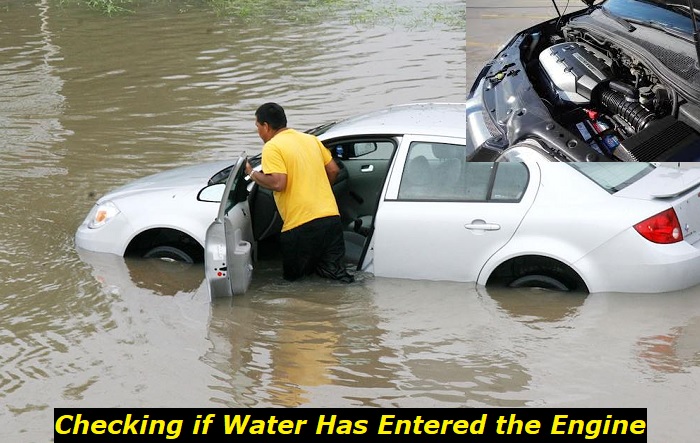If you have been driven around by an experienced driver and come across a puddle of water, you may have noticed the cautiousness they approach it. A newbie driver will splash the puddle of water without knowing what damage their car might suffer. Water entering the engine has been known to cause many car owners headaches, insurmountable losses, and stress.
Engine use issues highlights
- Level of importance:medium
- When done:driving the vehicle
- Cost of mistake:$250 - $3,500
- How to avoid:read driver's manual, learn more about the engine you have
- Consequences:inefficient driving, fatal engine issues
- DIY solutions:possible

How does water enter the engine?
If you live in an area that floods when it rains, you will likely know or have heard of the dangers of driving through flood water. But you may be living in the outback where crossing a river and streams is bound to happen once in a while. It is advisable to avoid situations where you drive through high water. Even six inches of water can reach the undercarriage of your vehicle. The damage that such water can visit upon you can be more than you can handle.
Most cars can handle a foot-deep puddle of water for a short moment. The problem comes when the water is deeper or if the vehicle remains in the water for an extended period. Water in the engine is mostly caused by drivers attempting to drive through flood water or river.
When the air intake system is exposed to water, there is a high likelihood that water will enter the engine. When enough water enters the engine, hydro-locking happens. This is considered a disaster in all aspects because the garage bill is usually extremely high. A small amount of water can enter the engine, which is our concern today.
The air intake for most cars is relatively high, and crossing a small puddle of water should not pose a threat. However, the vehicle's height determines how high up the intake is. Of course, a Ford Ranger's air intake is quite high compared to that of a Gallardo.
Souped-up cars are an art embraced by the youth, requiring the engine to be provided with the maximum possible amount of air. This forces some mechanics to redesign the intake and place a cone filter at the corner of the bumper. This is risky because any puddle of water reaching the bumper will mean the engine will take in liters of water.
What is hydro locking?
When the engine ingresses a substantial amount of water, it goes into the cylinders and this causes the engine to seize or to be severely damaged. Inside a combustion engine, the air-fuel mixture is injected into the combustion chamber which is then compressed by the piston to allow combustion. When water enters the combustion chamber, the piston cannot compress it.
The crankshaft is in motion and will keep rotating regardless of whether the piston can compress the water. Something has to give when this happens. If your car has a small engine, the motor will seize, and the engine will come to a stall. However, severe damage happens when a powerful engine, running at high speed, gulps a large volume of water. The connecting rods will break or bend, and the engine will most likely be totaled.
How to check if water has entered the engine
Sometimes the amount of water that enters the engine is not a lot. Some engines are more susceptible to getting water flooded than others. If you have passed through a puddle of water, crossed a river, or poured water on the engine, you should check if any water entered the engine. Here are a few steps to follow to check water in the engine;
- Pull the engine oil dipstick. If the oil appears milky and not caramel, then there is a high chance there is water in the engine. The oil can also seem diluted.
- Check whether the air filter is wet. The air filter should always be dry.
- When you confirm that the air filter is wet, the engine is sounding abnormal, and the engine oil is milkfish, don't attempt to start the car.
Steps to follow when water has entered the engine
- The first thing to do is not to attempt to start the engine
- Have the car towed to a garage where the water will be drained out of the engine.
- Disconnect the battery. This is not related to the water in the engine but to protect the car's wiring from short-circuiting.
- Replace the air cleaner if it is wet.
- Remove the air intake piping and inspect if there is any mud, water, or debris in case you suspect flood water entered the engine. Rinse the pipping and reinstall them.
- If you are a DIYer, drain all the engine and transmission fluid. Remember to drain the differential too. Remember, milky-looking engine oil indicates that water is in the sump.
- If the vehicle was exposed to flood water, remove each spark plug. The purpose of doing this is to ensure there is no water in the combustion chamber.
- You can crank or hand spin the engine to make any water in the combustion chamber come out through the spark plug holes.
- Siphon the fuel system to ensure no water enters the fuel tank. Remember that water is way heavier than car fuel, so ensure the siphoning is done from the bottom of the tank. If the tank had water, clean it before refilling it with fuel.
- Check the other fluids in the car to ensure no water got in. The clutch fluid, the brake fluid, and the power steering are some of the fluids to check.
- Check all the electrical wiring in the car. Water makes the wires corrode very fast. An expert best does this job as they will have a checklist to work with to ensure all systems are intact and will not cause the engine to stall at a later date.
The parts you should check to solve the problem
- Spark plugs - You should remove the spark plugs to enable you to pump out any water inside the combustion chamber. You can use the same plugs or buy new ones.
- Fuel filter - The fuel going into the engine must pass through the filter. You must replace the fuel filter if the water problem originated from the fuel tank.
- Oil filter - If the oil pan contains water, draining will not be enough. You will need to replace the oil filter.
- Fuel pump - If the fuel tank contains water, such water will be pumped by the fuel pump onto the engine. Such water can damage the pump. Remove the pump and inspect for any damage.
- Fuel tank - As stated earlier, water is denser than fuel and will settle at the bottom of the fuel tank. When removing such water, drain the tank from the bottom. Do not add additives in an attempt to get rid of the water.
What causes water to enter the engine
- Driving through puddles of water - As pointed out earlier, driving in a flooded area is the most likely cause of water in the engine. The water enters through the air intake and overcomes the air cleaner. The water finally finds its way into the combustion chamber and the engine oil sump.
- Head gasket failure - The head gasket seals the block and the head cylinder to ensure that the several fluids circulating around don't mix. The head gasket can let the coolant leak into the oil passageways if damaged. A head gasket will fail because a thermal expansion too quick for it to handle happened, making it crack.
- Injector leak - An injector can crack or get stuck open. This is quite rare, but some drivers have witnessed it. This malfunction makes fuel fill the combustion chamber, leading to a hydro lock.
Conclusion
As seen above, water in the engine can be categorized into two; a large quantity that causes hydro lock and a small amount that can be removed before any serious damage happens. In the case of a large amount of water entering the engine, there is a good chance you will incur huge losses, and in many cases, the vehicle may be written off by the insurance company.
If you suspect water has entered the engine, you mustn't attempt to start the engine. Have the car towed and attended to by a professional mechanic. Of course, ensure no water remains trapped in the car for an extended period because mildew, mold, rust, and serious damage can happen.
About the authors
The CarAraC research team is composed of seasoned auto mechanics and automotive industry professionals, including individuals with advanced degrees and certifications in their field. Our team members boast prestigious credentials, reflecting their extensive knowledge and skills. These qualifications include: IMI: Institute of the Motor Industry, ASE-Certified Master Automobile Technicians; Coventry University, Graduate of MA in Automotive Journalism; Politecnico di Torino, Italy, MS Automotive Engineering; Ss. Cyril and Methodius University in Skopje, Mechanical University in Skopje; TOC Automotive College; DHA Suffa University, Department of Mechanical Engineering






Add comment